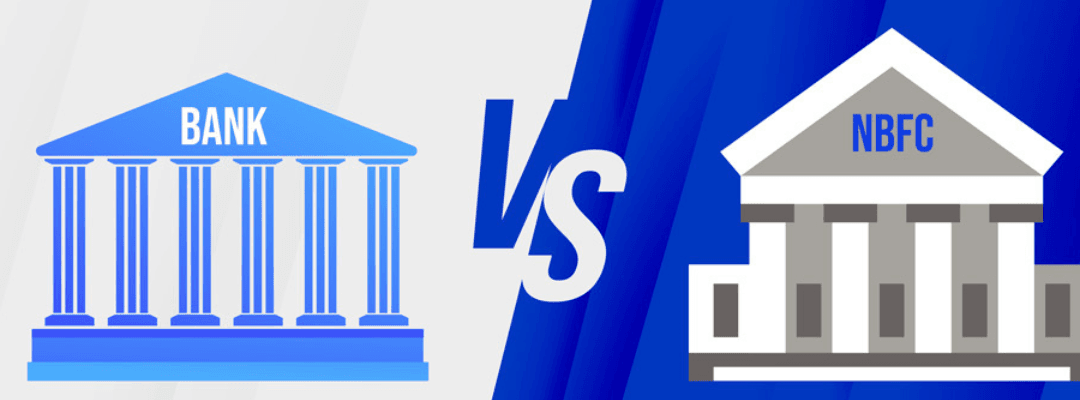A loan against property (LAP) is a secured loan where borrowers pledge their residential, commercial, or industrial property to raise funds for personal or business needs. When comparing a loan against property from a bank versus a Non-Banking Financial Company (NBFC) in India, the key differences revolve around interest rates, eligibility criteria, loan processing time, documentation, and flexibility. Here’s a detailed comparison:
1. Eligibility Criteria
- Banks:
- Banks have stricter eligibility criteria for loans against property. They typically require a high credit score (usually 700+), a stable income source, and a longer financial history. Banks often prefer salaried individuals or established businesses.
- Banks scrutinize the borrower’s creditworthiness closely, including factors like repayment history, existing debts, and property title clearance.
- NBFCs:
- NBFCs have more relaxed eligibility criteria and are more open to lending to individuals with lower credit scores (as low as 600) or those with shorter financial histories. They are more willing to lend to small businesses, self-employed individuals, or borrowers with fluctuating incomes.
- NBFCs focus more on the value and marketability of the property being pledged rather than just the borrower’s credit score.
2. Interest Rates
- Banks:
- Banks generally offer lower interest rates on loans against property because they have access to cheaper funds. Interest rates typically range from 8-12% per annum, depending on the borrower’s credit score, property type, and income profile.
- Banks offer both fixed and floating interest rates, with floating rates linked to the bank’s Marginal Cost of Lending Rate (MCLR).
- NBFCs:
- NBFCs usually charge higher interest rates compared to banks, typically ranging from 9-15% per annum. This is because NBFCs are willing to take on riskier borrowers or properties that may not meet stringent bank criteria.
- Interest rates from NBFCs may be slightly higher due to the higher flexibility they provide in terms of eligibility and documentation.
3. Loan Amount
- Banks:
- Banks typically offer higher loan amounts, particularly for borrowers with a strong credit profile and a high-value property. Loan amounts can range from ₹10 lakh to ₹10 crore or more, depending on the property’s market value and the borrower’s eligibility.
- Banks usually provide up to 60-70% of the property’s market value (Loan-to-Value ratio, or LTV).
- NBFCs:
- NBFCs also offer competitive loan amounts, but they may offer slightly lower amounts compared to banks for riskier borrowers or smaller properties. Typical loan amounts range from ₹5 lakh to ₹5 crore.
- NBFCs may offer a higher Loan-to-Value (LTV) ratio, sometimes up to 75-80% of the property’s market value, especially for borrowers with higher risks.
4. Loan Processing Time
- Banks:
- Banks generally take longer to process loans against property due to their rigorous evaluation processes. They carefully assess the borrower’s financial history, property valuation, and legal verification. Processing time can range from 2 to 4 weeks or more.
- NBFCs:
- NBFCs are known for faster loan processing. They often approve and disburse loans against property within 7 to 15 days, making them more suitable for borrowers who need quick access to funds.
- NBFCs tend to streamline property valuation and legal checks, enabling faster loan disbursement.
5. Documentation
- Banks:
- Banks require extensive documentation, including property papers, title clearance documents, income proof (salary slips, tax returns), bank statements, and business financials (for self-employed individuals). This thorough process ensures a lower risk for the bank but leads to slower approval times.
- NBFCs:
- NBFCs have simplified documentation requirements compared to banks. While they still need property papers and title clearance, they are more lenient regarding income proof and financial documents, speeding up the approval process.
6. Repayment Tenure
- Banks:
- Banks typically offer longer repayment tenures, ranging from 5 to 15 years, and sometimes up to 20 years. This makes the EMIs smaller and more affordable, especially for large loan amounts.
- Longer tenures allow borrowers to spread out payments and reduce monthly financial pressure.
- NBFCs:
- NBFCs generally provide slightly shorter tenures, typically between 3 to 10 years, though some NBFCs may offer longer tenures for high-value loans. While the shorter tenure means higher EMIs, NBFCs often provide flexible repayment plans.
- NBFCs may offer customized repayment schedules, such as step-up EMIs or bullet payments, based on the borrower’s cash flow and needs.
7. Loan Disbursement
- Banks:
- Banks generally follow a more structured disbursement process, where the loan is disbursed in a lump sum after completing all legal and valuation checks.
- They tend to release funds only after verifying the complete property documentation, which can slow down the disbursement process.
- NBFCs:
- NBFCs are more flexible with disbursement, often allowing faster release of funds once essential documents are verified. This makes them more responsive to borrowers’ urgent financial needs.
8. Flexibility
- Banks:
- Banks are generally less flexible when it comes to structuring loan terms, interest rates, and repayment schedules. They follow a standardized loan process with limited room for negotiation, especially for borrowers without a long-standing relationship with the bank.
- NBFCs:
- NBFCs tend to offer more flexibility in loan structuring, allowing borrowers to customize repayment schedules, EMI options, and even loan amounts based on their needs. This makes NBFCs more attractive to borrowers with unique financial situations.
9. Credit Score Requirements
- Banks:
- Banks usually require a higher credit score, typically above 700, to approve a loan against property. A high credit score allows borrowers to access lower interest rates and better loan terms.
- NBFCs:
- NBFCs are more lenient with credit scores and may approve loans for individuals with credit scores as low as 600. However, borrowers with lower credit scores may face higher interest rates and stricter loan conditions.
10. Prepayment and Foreclosure Charges
- Banks:
- Banks often allow prepayment or foreclosure of the loan but may charge penalties for doing so, especially in the early years of the loan tenure. Some banks waive these charges after a certain period.
- Prepayment charges for banks are usually between 2-4% of the outstanding loan amount.
- NBFCs:
- NBFCs generally have higher prepayment and foreclosure charges compared to banks. However, some NBFCs offer loans with no prepayment penalties, especially for loans with shorter tenures or smaller amounts.
- It is essential to check the specific terms offered by the NBFC, as prepayment policies can vary.
11. Risk Appetite
- Banks:
- Banks have a lower risk appetite and prefer lending to individuals with stable incomes, strong financial backgrounds, and properties with clear legal titles. They are more conservative in their lending practices.
- NBFCs:
- NBFCs have a higher risk appetite and are more open to lending to riskier borrowers, such as those with lower credit scores or businesses with fluctuating cash flows. This makes NBFCs a better option for individuals who may not qualify for a bank loan.
12. Customer Service and Support
- Banks:
- Banks offer standardized customer service, with support available through branches, phone, and online channels. However, the service may not be as personalized, especially for smaller or first-time borrowers.
- NBFCs:
- NBFCs generally offer more personalized and responsive customer service. They are known for quicker responses to loan queries and more tailored support, especially for borrowers seeking flexible loan solutions.
Summary: Banks vs NBFCs for Loan Against Property
| Criteria | Banks | NBFCs |
|---|---|---|
| Eligibility Criteria | Stricter, higher credit score required | More lenient, lower credit score accepted |
| Interest Rates | Lower (8-12%) | Higher (9-15%) |
| Loan Amount | Higher amounts available (up to ₹10 crore) | Competitive, slightly lower (up to ₹5 crore) |
| Loan Processing Time | Slower (2-4 weeks) | Faster (7-15 days) |
| Documentation | Extensive | Simplified |
| Repayment Tenure | Longer (5-20 years) | Shorter (3-10 years) |
| Loan Disbursement | Structured, after complete checks | Faster, flexible schedules |
| Flexibility | Less flexible loan terms | More flexible, customized solutions |
| Credit Score Requirements | Higher (700+) | Lower |

